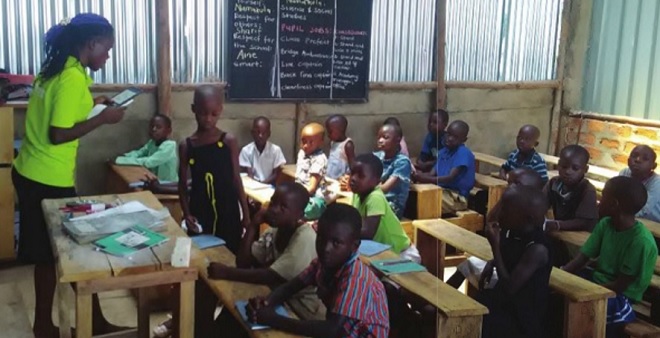
Education Ministry and closed chain of low-cost schools said to be holding `sensitive talks’
Bridge International Academies is locked in last-minute negotiations with government in order to open with other schools when the new term begins this February, insiders say.
As the school year closed in 2016, the government used a court order and state force, in an attempt to force the chain of 63 Bridge International Academies across the country to close. The Ministry of Education cited alleged poor learning conditions; including poorly built classrooms, lack of proper licences, and use of unqualified teachers.
The closure of the low-cost schools partly funded by Bill Gates and Mark Zuckerberg, respectively the founders of Microsoft and Facebook, followed court battles and public confrontations.
As schools across the country prepared to reopen for 1st term 2017, officials in charge of the Bridge Schools told The Independent they were holding “sensitive talks” with the government. They refused to explain the nature of the talks or whether they would lead to Bridge Academies freely operating. As a result, even as the question is already drawing a lot of attention, it remains unclear whether Bridge Schools will be allowed to operate.
At stake is the future of 12,000 pupils attending Brigde schools across the country and its first cohort of pupils supposed to sit their first Primary Leaving Examinations (PLE). In some localities, community leaders told The Independent that the schools would reopen.
“We have been meeting with parents to remind them that the schools will continue operating,” says Richard Katesa, an LC 1 chairman in Nsumbi village Wakiso, “Even yesterday I was at the school and all will be normal.”
Katesa’s area is home to Bridge Academy Nsumbi, which he says was received well in his area and where parents even held a demonstration to protest the court order closing the schools.
“The government has been telling lies about Bridge Schools,” says Katesa, “Pupils have been studying and nothing wrong has happened. We resisted the attempts of some authorities to close the schools.”
But away from Katesa, Bernard Muyanja, the LC 1 Kirulumba Ward in Kiboga district, says he is confused about the fate of Bridge Academy Kiboga which is in his area.
“The government says this and the schools say that,” he says, “I don’t know what to believe.”
Muyanja and Katesa are one of many people who have been caught right in the middle of the saga between the government and Bridge International Academies.
According to Bridge, its strategy was to establish its academies in deep lying remote areas like Kiboga to fulfil its philosophy of ‘education for all’. Bridge says it was trying to plug a gaping hole in Uganda’s education infrastructure- the absence of classrooms, desks and other materials that make a studying environment conducive.
Indeed, Goretti Nakabugo, the Country Coordinator of UWEZO, an education non-profit organisation, says government can learn a few things from Bridge schools. As an example, she cites the schools’ model of Continuous Professional Development, where teachers are taken for training during holidays especially now that there is a new policy at the ministry on continuous training for teachers.
This, she said, has been lacking in both government and private schools.
“The minimum entry requirement is just a S4 certificate and these teachers need to receive more training which can be a source of motivation for them to deliver.” She added “Government schools have bigger share of trained teachers but private schools somehow perform better.”
She also cited Bridge’s use of computer tablets as a way of integrating Information Technology as another learning point for government.
“Well some people think the lessons do not empower teachers because they are just laid out but we can still pick something from their example,” she said.
Nakabugo hopes that Bridge irons out three issues which continue to haunt it. “They should sort out their licensing issues with the various local governments,” she told The Independent, “Have an open door policy so that inspectors can always come in and check what is happening at these schools, such as the lessons being taught. Then the teachers should be empowered. The idea of them conducting lessons on a tablet is commendable but it takes something away from the teacher’s abilities.”
Bridge’s troubles reached a climax in November last year, when Judge Patricia Basaza Wasswa ordered its closure following a lengthy battle with government.
The judge reasoned that the role of the courts was to support the efforts of the Ministry of education in uplifting the education standards in the country and not trying to put them down. The schools quickly filed a stay of execution before the day could end.
The ruling was a major blow to Bridge International, which had been expanding rapidly since inception in 2015. Resistance from teachers and members of the community did not help matters.
Bridge’s many foes
In spite of what Bridge has put in place with its investment of Shs10billion that has created jobs and given an education to thousands of children, its number of foes keeps piling up.
James Tweheyo, the Uganda National Teachers Union (UNATU) Secretary General attacked Bridge schools last year saying besides being sub-standard, they did not have latrines.
 The Independent Uganda: You get the Truth we Pay the Price
The Independent Uganda: You get the Truth we Pay the Price




What is meant by “sub-standard” buildings? Bridge International Academies have are in a nascent phase and they have a long term plan to establish themselves as standard schools with time. Rome was built, but not in onde day.
What is meant by “sub-standard” buildings? Bridge International Academies are in a nascent phase and they have a long term plan to establish themselves as standard schools with time. Rome was built, but not in one day.